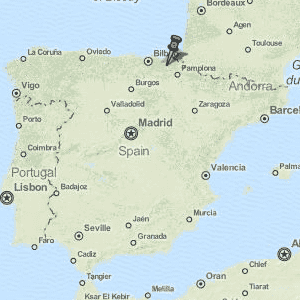We were up early that morning to drive to the Basque Country.
Though called "country," it's not an independent territory. Rather, it straddles two different countries - the northwest of Spain and the southwest of France.
The Northern Basque Country lies within France, thus its other name, French Basque Country. It consists of the provinces of Labourd, Lower Navarre (where Saint-Jean-Pied-de-Port, the most common starting point of the pilgrims' Camino de Santiago journey, is located), and Soule.
The Lower Basque Country lies within Spain, and is, of course called, Spanish Basque Country. It consists of the Basque Autonomous Community (composed of three provinces designated as "historical territories" - Alava, Biscay, and Gipuzkoa) and the single autonomous province of Navarre.
But it is a world on its own because this region is inhabited by what they say is the oldest ethnic group in Europe, with a totally different culture and language from the Spanish and the French. In addition, the Basque people come from a unique gene pool that is distinct from the rest of Europe. Intrigued enough?
Personally, I was pretty excited to visit a section of the Basque Country for three reasons.
First, the Basque people and their history have always been a source of fascination for me. Their heritage, shrouded in mystery, still baffles historians and anthropologists. Their culture, totally different, not only from the rest of Spain and France, but also from the rest of Europe, remains a puzzle to those trying to trace their origins. They are genetically different from the rest of the European population, based on DNA analysis. Their language is isolated, utterly unrelated to any language or dialect in the world in vocabulary, syntax, and grammatical structure. It is even speculated by scholars of esoteric studies that the Basque people are the descendants of the Atlanteans, the highly advanced race that populated the legendary lost continent of Atlantis, and in the 16th to the 17th century, it was believed that their language, called Euskara, was the language spoken in the Garden of Eden. How enigmatic is that?
Second, I love high-elevation places. There is something exhilarating about being there. Geographically speaking, the Basque Country is mountainous, with most of the mountains running along an east-west axis on the western side of the Pyrenees. The Basque highlands are also characterized by limestones and granite.
Third, we are visiting the Sanctuary of Loyola, built in honor of Saint Ignatius of Loyola, founder of the Jesuit religious order. This would be a very personal visit for me. I studied at a Jesuit university and have a high regard for this society of priests and brothers known for their spirituality, scholarship, and humanitarianism.
The sanctuary is located in Azpeitia (which means “down the rock” in Basque), a town within the province of Gipuzkoa, one of the three provinces that comprise the Basque Autonomous Community in Spain. This town is the actual birthplace of Saint Ignatius. In fact, his birth home is now preserved as a part of the large Jesuit compound in the sanctuary.
Azpeitia lies at the foot of the massive Izarraitz range towering over the town. Our ride through the interior of Gipuzkoa took us to magnificent landscapes of valleys and mountains. It was evident in the wide-open spaces that the Basque region is very sparsely populated compared to the other cities of northern Spain that we passed through. I saw a lot of farmhouses with sheep herders nearby, tending to their flocks.
The scenery reminded me a little bit of Austria and Switzerland, minus the chalets. The mountain vista evoked a feeling of familiarity, yet elicited a disparate element at the same time. I guess the best way to describe it is to quote our Tour Director’s favourite expression, “Same, same, but different.”
Photo Credits:
freecountrymaps.com, bitsystage.com, istockphoto.com, themayor.eu, civitatis.com, spainisculture.com, Josu (Wikimedia Creative Commons)

























Comments